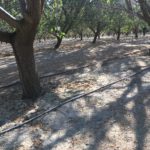 The reduced late fall rains have led to relatively dry conditions throughout the State. Within the San Joaquin Valley, limited amounts of rain have fallen, with recorded precipitation around one inch in Merced. The lack of rain has led to a series of questions about winter irrigation requirements in which answers are included.
The reduced late fall rains have led to relatively dry conditions throughout the State. Within the San Joaquin Valley, limited amounts of rain have fallen, with recorded precipitation around one inch in Merced. The lack of rain has led to a series of questions about winter irrigation requirements in which answers are included.
Question (Q). Do I need to irrigate now?
Answer (A). Evapotranspiration rates are very low and almond water use is even lower. A table has been included that has utilized the real-time evapotranspiration data (ETo), the corresponding crop coefficients (Kc), almond evapotranspiration (ETc) and rainfall for the MERCED CIMIS station. The need to irrigate should be based on almond water use, the amount of water that has been applied in the Late October through early December period, and rainfall.
| Week Starting: | ETo | Kc | ETc (in) | Rain (in) |
| Nov 5th | 0.48 | 0.69 | 0.3312 | |
| Nov 12th | 0.38 | 0.69 | 0.2622 | 0.71 |
| Nov 19th | 0.34 | 0.6 | 0.204 | |
| Nov 26th | 0.32 | 0.6 | 0.192 | 0.27 |
| Dec 3rd | 0.3 | 0.4 | 0.12 | |
| Total: | 1.82 | 1.1094 | 0.98 |
Based on this example, ETc for the month of November and first week of December has been 1.11” with roughly 0.98” of rainfall. This suggests that an irrigation may be needed. If, however, any irrigation was applied in late October or November, most likely the water needs have been met.
Water demands and rainfall are site specific. Determining the situation for the orchard location will be needed to determine localized water needs. When in doubt, checking soil moisture status may assist with the decision making.
Q. I didn’t irrigate in Late October – December and rainfall has been limited, how do I apply the water?
A. Irrigation sets should be shorter than 24 hours to reduce saturated soil conditions and the risk of Phytophthora. If puddling occurs in a 24 hour period, reduce the set length. As illustrated above, it doesn’t take much water to meet demands and as the days get colder, this amount will drop. Usually, a single set or two will meet the need of the orchard.
Q. What is the consequence of not irrigating or filling the soil profile?
A. If water needs of the tree are met but the soil profile is not filled, irrigation in the following spring will most likely need to begin earlier. Keep in mind that the wettest months in California are January/February, so enough rain to fill the profile may fall by then.
In the cases in which tree demands aren’t met, the research done suggests a minimal effect. Recent work by M. Rawls (a Grad student for Dr. K. Shackel) has found that floral bud morphology is not affected by water stress in dormancy, but bloom timing can be delayed.
Q. What if I want to fill the soil profile or leach salts?
A. This is a different question altogether. When filling the profile, the guidance of sets of 24 hours or less should be followed to reduce the risk of wet feet and disease. Water should be applied with 2-3 days in between before another set is applied. This may take several irrigation sets. Running one long set is not typically advised as puddling and soil saturation can create disease issues.
If attempting to leach DUE TO HIGH SOIL SALINITY LEVELS, the profile must be filled first. Applications should be continued following the procedure described above (1 day on, 2-4 days off). Determining the amount needed is a bit tricky as it depends on the salinity levels and soil texture. Please see the local Farm Advisor or Agronomist for help. More information on salinity management.
Most likely it will be harder to apply more than 12” of water. This amount (or more) will be needed to leach loams or finer textured soils. Sandier soils will not take as much water. Only consider leaching if salt levels within the rootzone are high. Ideally, programs should be completed by the end of January.
Q. Does applying water now bring my trees out of dormancy?
A. No. Experience in other trees suggests it will do the opposite.


Jim Finderup
December 16, 2017I used to get your emails. I keep trying to sign up, but you reply I’m already signed up. I haven’t gotten your emails for at least six months?
Chris Morgner
December 16, 2017Great info, especially concerning current water demand and need for irrigation.
I have seen a lot of almond orchards being irrigated in the last 2 weeks and inquired with a few growers why they were watering. “To incorporate my residual herbicides”, “It’s so dry and the trees are thirsty!”. “I’m doing my year end system maintenance”.
The lack of rain will likely require filling the soil root zone and this can begin anytime. Follow the above guidelines, especially stopping irrigation by the end of January.
Leaching for salts should begin now to have enough time to get the required amount of water applied before root activity accelerates in late January.
David Doll
December 16, 2017Thanks Chris for the comments. I agree on the points mentioned.
David